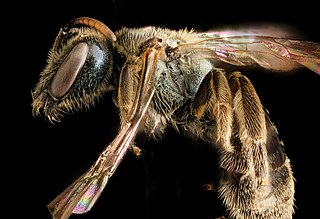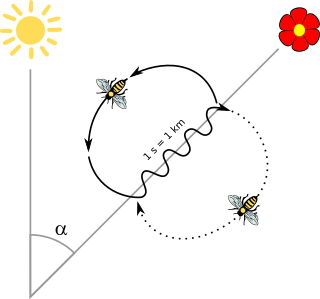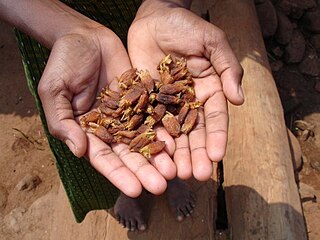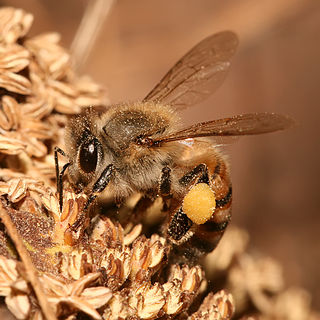
A herbivore is an animal anatomically and physiologically adapted to eating plant material, for example foliage or marine algae, for the main component of its diet. As a result of their plant diet, herbivorous animals typically have mouthparts adapted to rasping or grinding. Horses and other herbivores have wide flat teeth that are adapted to grinding grass, tree bark, and other tough plant material.

A honey bee is a eusocial, flying insect within the genus Apis of the bee clade. They are known for construction of perennial, colonial nests from wax, for the large size of their colonies, and for their surplus production and storage of honey, distinguishing their hives as a prized foraging target of many animals, including honey badgers, bears and human hunter-gatherers. In the early 21st century, only seven species of honey bee are recognized, with a total of 44 subspecies, though historically seven to eleven species are recognized. The best known honey bee is the Western honey bee which has been domesticated for honey production and crop pollination; modern humans also value the wax for candlemaking and other crafts. Honey bees represent only a small fraction of the roughly 20,000 known species of bees. Some other types of related bees produce and store honey and have been kept by humans for that purpose, including the stingless honey bees, but only members of the genus Apis are true honey bees. The study of bees, which includes the study of honey bees, is known as melittology.

The term pollinator decline refers to the reduction in abundance of insect and other animal pollinators in many ecosystems worldwide beginning at the end of the 20th century, and continuing into the present.

Honey bees are sensitive to odors, tastes, and colors, including ultraviolet. They can demonstrate capabilities such as color discrimination through classical and operant conditioning and retain this information for several days at least; they communicate the location and nature of sources of food; they adjust their foraging to the times at which food is available; they may even form cognitive maps of their surroundings.

Bee pollen is a ball or pellet of field-gathered flower pollen packed by worker honeybees, and used as the primary food source for the hive. It consists of simple sugars, protein, minerals and vitamins, fatty acids, and a small percentage of other components. Also called bee bread, or ambrosia, it is stored in brood cells, mixed with saliva, and sealed with a drop of honey. Bee pollen is harvested as food for humans, with various health claims, one of them being that the fermentation process makes it much more potent than simple flower pollen.

Waggle dance is a term used in beekeeping and ethology for a particular figure-eight dance of the honey bee. By performing this dance, successful foragers can share information about the direction and distance to patches of flowers yielding nectar and pollen, to water sources, or to new nest-site locations with other members of the colony.

Bait fish are small fish caught for use as bait to attract large predatory fish, particularly game fish. Species used are typically those that are common and breed rapidly, making them easy to catch and in regular supply. Examples of marine bait fish are anchovies, gudgeon, halfbeaks such as ballyhoo, and scad. Some larger fish such as menhaden, flying fish, or ladyfish may be considered bait fish in some circles, depending on the size of the gamefish being pursued.
Freshwater bait fish include any fish of the minnow or carp family (Cyprinidae), sucker family (Catostomidae), top minnows or killifish family (Cyprinodontidae), shad family (Clupeidae), sculpin of the order Osteichthyes and sunfish family (Centrarchidae), excluding black basses and crappies.

Optimal foraging theory (OFT) is a behavioral ecology model that helps predict how an animal behaves when searching for food. Although obtaining food provides the animal with energy, searching for and capturing the food require both energy and time. To maximize fitness, an animal adopts a foraging strategy that provides the most benefit (energy) for the lowest cost, maximizing the net energy gained. OFT helps predict the best strategy that an animal can use to achieve this goal.

In zoology, a palynivore /pəˈlɪnəvɔːɹ/, meaning “pollen eater” is an herbivorous animal which selectively eats the nutrient-rich pollen produced by angiosperms and gymnosperms. Most true palynivores are insects or mites. The category in its strictest application includes most bees, and a few different kinds of wasps, as pollen is often the only solid food consumed by all life stages in these insects. However, the category can be extended to include more diverse species. For example, palynivorous mites and thrips typically feed on the liquid content of the pollen grains without actually consuming the exine, or the solid portion of the grain. Additionally, the list is expanded greatly if one takes into consideration species where either the larval or adult stage feeds on pollen, but not both. There are other wasps which are in this category, as well as many beetles, flies, butterflies, and moths. One such example of a bee species that only consumes pollen in its larval stage is the Apis mellifera carnica. There is a vast array of different insects that will feed opportunistically on pollen, as will various birds, orb-weaving spiders and other nectarivores.

Non-timber forest products (NTFPs), also known as non-wood forest products (NWFPs), minor forest produce, special, minor, alternative and secondary forest products, are useful substances, materials and/or commodities obtained from forests which do not require harvesting (logging) trees. They include game animals, fur-bearers, nuts, seeds, berries, mushrooms, oils, foliage, pollarding, medicinal plants, peat, mast, fuelwood, fish, spices, and forage.

In ethology and behavioral ecology, trap-lining or traplining is a feeding strategy in which an individual visits food sources on a regular, repeatable sequence, much as trappers check their lines of traps. Traplining is usually seen in species foraging for floral resources. This involves a specified route in which the individual traverses in the same order repeatedly to check specific plants for flowers that hold nectar, even over long distances. Trap-lining has been described in several taxa, including bees, butterflies, tamarins, bats, rats, and hummingbirds and tropical fruit-eating mammals such as opossums, capuchins and kinkajous. Traplining is used to term the method in which bumblebees and hummingbirds go about collecting nectar, and consequently, pollinating each plant they visit. The term "traplining" was originally coined by Daniel Janzen, although the concept was discussed by Charles Darwin and Nikolaas Tinbergen.
In computer science and operations research, the bees algorithm is a population-based search algorithm which was developed by Pham, Ghanbarzadeh et al. in 2005. It mimics the food foraging behaviour of honey bee colonies. In its basic version the algorithm performs a kind of neighbourhood search combined with global search, and can be used for both combinatorial optimization and continuous optimization. The only condition for the application of the bees algorithm is that some measure of distance between the solutions is defined. The effectiveness and specific abilities of the bees algorithm have been proven in a number of studies.

Clothianidin is an insecticide developed by Takeda Chemical Industries and Bayer AG. Similar to thiamethoxam and imidacloprid, it is a neonicotinoid. Neonicotinoids are a class of insecticides that are chemically similar to nicotine, which has been used as a pesticide since the late 1700s. Clothianidin and other neonicotinoids act on the central nervous system of insects as an agonist of acetylcholine, the neurotransmitter that stimulates nAChR, targeting the same receptor site (AChR) and activating post-synaptic acetylcholine receptors but not inhibiting AChE. Clothianidin and other neonicotinoids were developed to last longer than nicotine, which is more toxic and which breaks down too quickly in the environment. However, studies published in 2012 show that neonicotinoid dust released at planting time may persist in nearby fields for several years and be taken up into non-target plants, which are then foraged by bees and other insects.

Thiamethoxam is a systemic insecticide in the class of neonicotinoids. It has a broad spectrum of activity against many types of insects. Thiamethoxam affects bumblebees negatively according to independent European scientific studies from 2014 and 2016.

Bombus impatiens, the common eastern bumble bee, is the most commonly encountered bumblebee across much of eastern North America. They can be found in the Eastern temperate forest region of the eastern United States, southern Canada, and the eastern Great Plains. Because of their great adaptability, they can live in country, suburbs, and even urban cities. This adaptability makes them a great pollinator species, leading to an increase in their commercial use by greenhouse industry. This increase consequently led to their farther spread outside their previous distribution range. They are considered one of the most important species of pollinator bees in North America.

Trigona corvina is a species of stingless bee that lives primarily in Central and South America. In Panama, they are sometimes known as zagañas. They live in protective nests high in the trees, but they can be extremely aggressive and territorial over their resources. They use their pheromones to protect their food sources and to signal their location to nest mates. This black stingless bees of the tribe Meliponini can be parasitic toward citrus trees but also helpful for crop pollination.


















